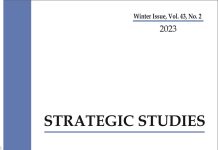Abstract:
Pakistan’s testing of the nuclear-capable tactical ballistic missile ‘Nasr’ and its India’s counterpart ‘Prahaar’ has renewed a debate on deterrence stability in South Asia. The introduction of tactical nuclear weapons (TNW) by Pakistan is a result of heightened threat perceptions resulting from India’s development of ballistic missile defence (BMD), its pursuit of the aggressive limited war doctrine Cold Start, and Pakistan’s growing conventional military imbalance with India. The pursuit of TNW presents a stabilisation-destabilisation dilemma for Pakistan. While demonstration of TNW capability may be stabilising for Pakistan, since it aims to deter India from pursuing limited war, the actual deployment and use of the weapons in the battlefield is destabilising, since it presents a host of problems such as dangers of pre-emption, complicated command and control, risk of advertent and inadvertent use, and issues of escalation control, which make deterrence highly unstable. The paper argues that one way out of this stabilisation-destabilisation dilemma may be to deploy a limited number of weapons for signalling or warning to India, instead of opting for large-scale battlefield deployment, which has the potential of escalation to an all-out war.













